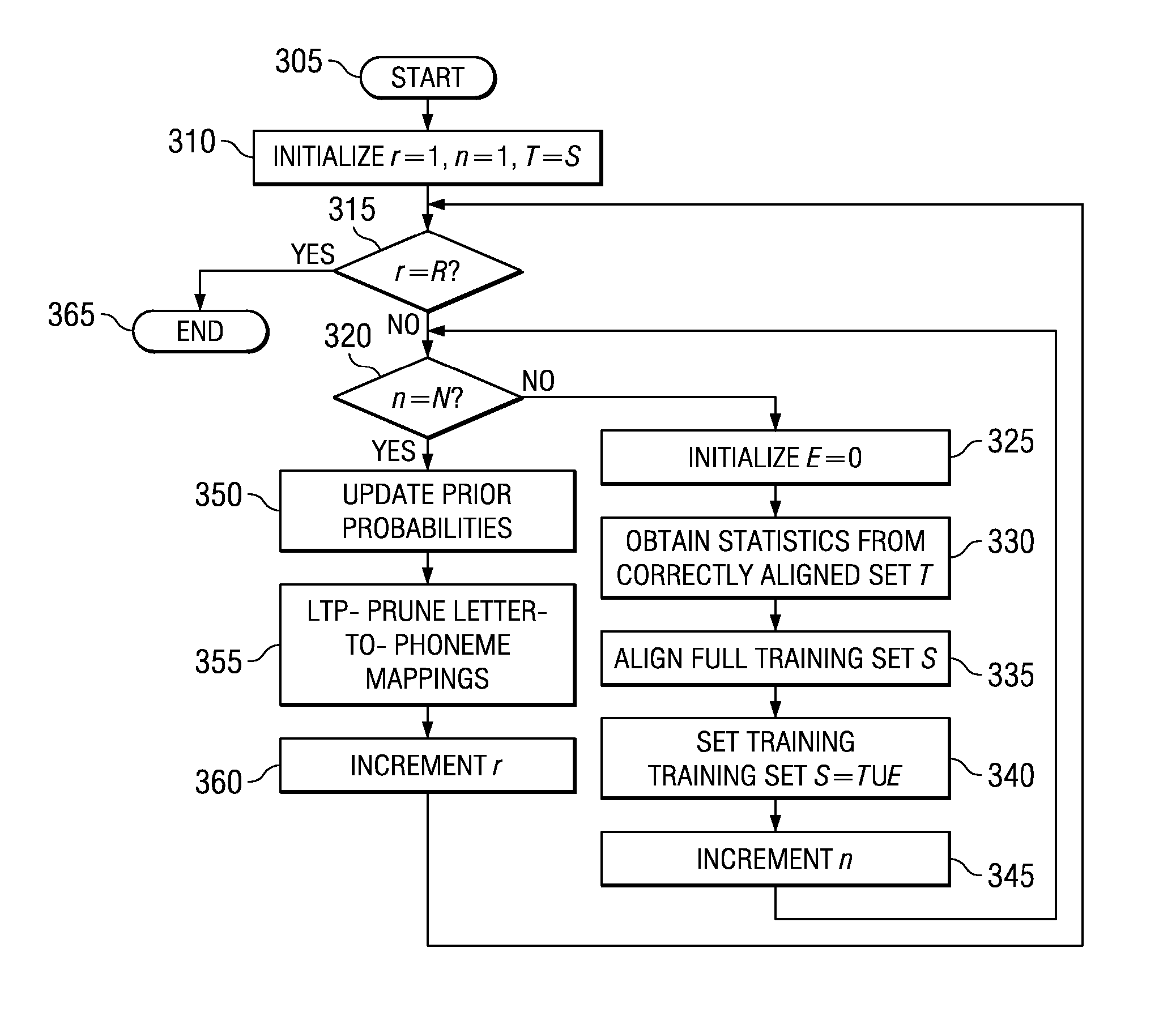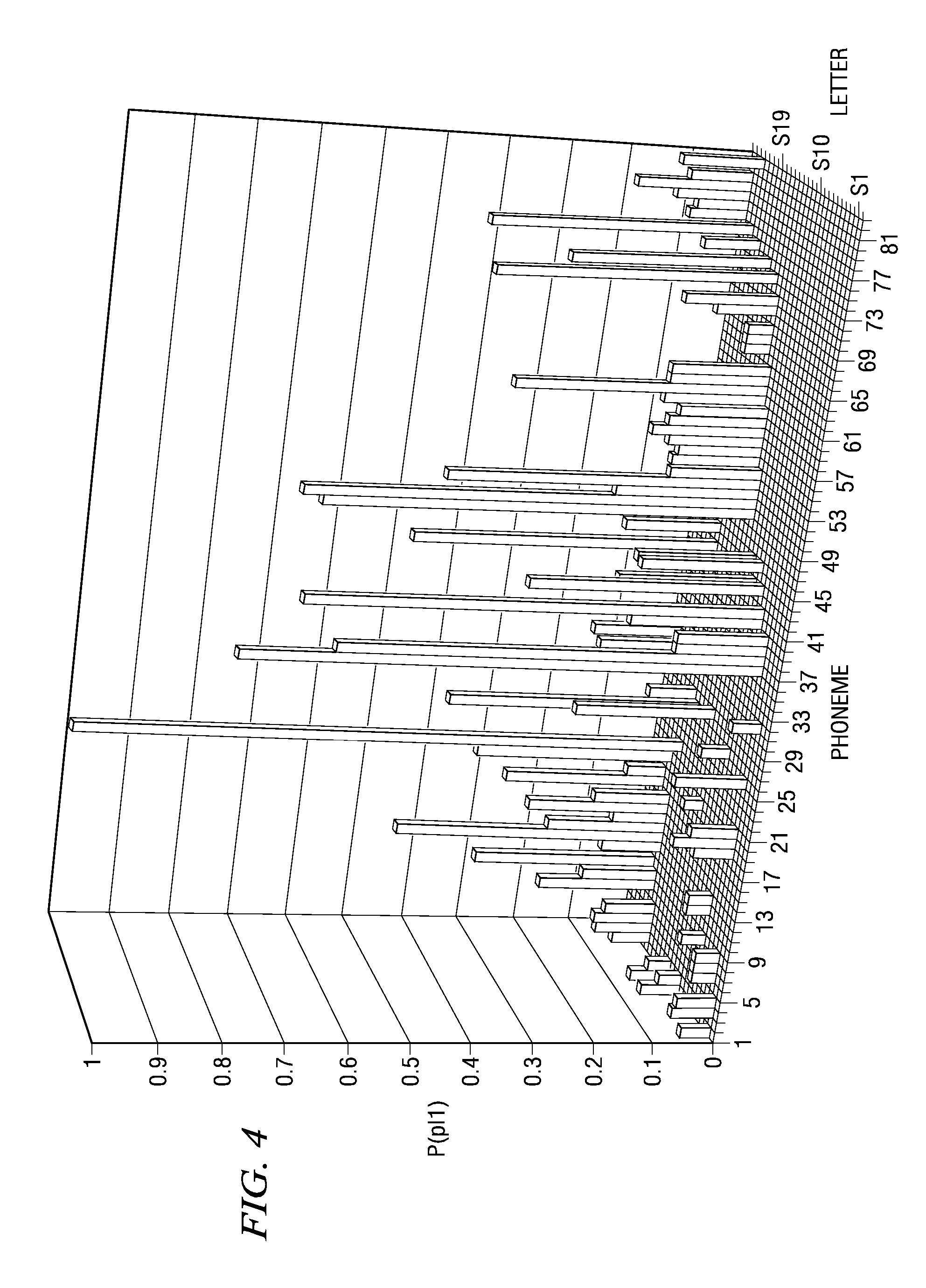System and method for text-to-phoneme mapping with prior knowledge
a text-to-phoneme and mapping technology, applied in the field of automatic speech recognition, can solve the problems of inability to provide sind in mobile telecommunication devices, inability to use large dictionary with many entries, and poor performance of rule-based approaches
- Summary
- Abstract
- Description
- Claims
- Application Information
AI Technical Summary
Problems solved by technology
Method used
Image
Examples
experiment 1
[0089] TTP as a Function of the Inner-Loop Iteration Number n
[0090]FIGS. 4 and 5 show the estimated posterior probability of a particular phoneme given a particular letter P(p|l) (θA=0.003). FIG. 5 with n=5 is more ordered than FIG. 4 with n=1 at initialization. Encouragingly, the strongest peaks at convergence n=5 are also among the strongest peaks at n=1. This indicates that the naive initialization provides an effective starting point for the technique of the present invention.
[0091] At convergence, some posterior probabilities become zero, for example, the posterior probability of “w_ah” given the letter “A.” This observation suggests that the TTP technique properly regularizes training cases for DTPM by removing some LTP mappings with low posterior probability.
[0092] Entropy may be used to measure the irregularity of LTP mapping. The entropy is defined as P(p|l)log 1P(p|l).
Averaging over all LTP pairs, the averaged entropy at initialization was determined to be 0.78. ...
experiment 2
[0093] TTP as a Function of the Outer-Loop Iteration Number r
[0094]FIG. 6 shows word error rates in different driving conditions as a function of memory size of un-pruned DTPMs (un-pruned DTPMs were trained without the DTPM-pruning process described above). (θA=0.003). The memory size was smaller with when the outer-loop iteration number r was increased.
[0095] Table 2 shows LTP mapping accuracy as a function of the iteration r for the un-pruned DTPMs.
TABLE 2LTP Alignment Accuracy as a Function of Outer-Loop Iteration rIteration Number r1234LTP accuracy (in %)91.4288.1683.1679.04Memory size (Kbytes)579458349249
Table 2 shows that, although the size of DTPMs was smaller with increased outer-loop iteration, LTP accuracy was lower, and recognition performance degraded. A similar trend can be observed for a pruned-DTPM that uses the DTPM-pruning process described above. This trend result from the fact that, at each iteration r, the LTP-pruning process may remove some LTP mappings wit...
experiment 3
[0100] Performance as a Function of Probability Threshold θA
[0101] A parameter, probability threshold θA, is used for LTP-pruning those LTP with low a posteriori probability P(p|l). The larger the threshold θA, the fewer the number of LTP mappings are allowed. This section presents results with a set of θA using HMM-1. Experimental results are shown in Table 3, below, together with a plot of the recognition results in FIG. 8. In FIG. 8, the line 810 represents the highway driving condition; the line 820 represents the city driving condition; and the line 830 represents the parked condition.
TABLE 3WER of WAVES Name RecognitionAchieved by Un-Pruned DTPMθA0.00000.000010.000050.00010.0003Highway11.2811.3611.1911.7711.23drivingCity4.044.043.834.543.96drivingParked2.162.081.952.041.99Size244244244244243(Kbytes)LTP Acc83.7388.7388.7688.6788.67(in %)θA0.00050.0010.0030.0050.01Highway11.2311.329.9010.1410.04drivingCity4.044.133.563.903.94drivingParked1.992.041.671.751.75Size2432392312292...
PUM
 Login to View More
Login to View More Abstract
Description
Claims
Application Information
 Login to View More
Login to View More - R&D
- Intellectual Property
- Life Sciences
- Materials
- Tech Scout
- Unparalleled Data Quality
- Higher Quality Content
- 60% Fewer Hallucinations
Browse by: Latest US Patents, China's latest patents, Technical Efficacy Thesaurus, Application Domain, Technology Topic, Popular Technical Reports.
© 2025 PatSnap. All rights reserved.Legal|Privacy policy|Modern Slavery Act Transparency Statement|Sitemap|About US| Contact US: help@patsnap.com



